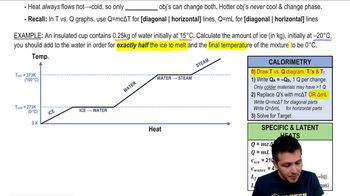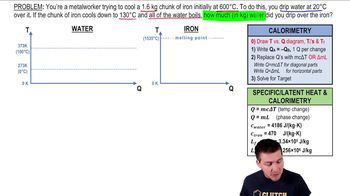20. Heat and Temperature
Calorimetry with Temperature and Phase Changes
20. Heat and Temperature
Calorimetry with Temperature and Phase Changes
Additional 4 creators.
Learn with other creators
Showing 7 of 7 videos
Practice this topic
- Open Question. A vessel whose walls are thermally insulated contains 2.40 kg of water and 0.450 kg of ice, all at 0.0°C. The outlet of a tube leading from a boiler in which water is boiling at atmospheric pressure is inserted into the water. How many grams of steam must condense inside the vessel (also at atmospheric pressure) to raise the temperature of the system to 28.0°C? You can ignore the heat transferred to the container.
- Open QuestionA 4.00-kg silver ingot is taken from a furnace, where its temperature is 750.0°C, and placed on a large block of ice at 0.0°C. Assuming that all the heat given up by the silver is used to melt the ice, how much ice is melted?
- Open QuestionAn insulated beaker with negligible mass contains 0.250 kg of water at 75.0°C. How many kilograms of ice at -20.0°C must be dropped into the water to make the final temperature of the system 40.0°C?
- Open QuestionA laboratory technician drops a 0.0850-kg sample of unknown solid material, at 100.0°C, into a calorimeter. The calorimeter can, initially at 19.0°C, is made of 0.150 kg of copper and contains 0.200 kg of water. The final temperature of the calorimeter can and contents is 26.1°C. Compute the specific heat of the sample









